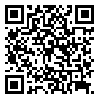BibTeX | RIS | EndNote | Medlars | ProCite | Reference Manager | RefWorks
Send citation to:
URL: http://hayat.tums.ac.ir/article-1-1300-en.html
2- Nursing and Midwifery Care Research Center, Dept. of Community Health Nursing, School of Nursing and Midwifery, Tehran University of Medical Sciences, Tehran ,
3- Ph.D Student in Biostatistics, School of Paramedical Sciences, Shahid Beheshti University of Medical Sciences, Tehran
Background & Aim: Evidence-based practice (EBP) education is essential in nursing education. Therefore, identifying factors influencing nurses' adoption of EBP is very important to perform optimum quality nursing interventions. The aim of present study was to determine the factors affecting the adoption of EBP based on Rogers' diffusion of innovations models in nurses.
Methods & Materials: This was a descriptive–analytical study. The research subjects were 130 nurses who worked in the hospitals affiliated to Tehran University of Medical Sciences in 2014. The research instruments were four questionnaires including demographic data; knowledge, attitude and the adoption of EBP; individual innovation and perceived attributes of EBP. Data were analyzed by descriptive and inferential statistics (Pearson correlation coefficient and path analysis) on SPSS v.19 and EQS.
Results: The study findings showed that age and the working experiences of nurses had significant inverse relationships with knowledge of EBP (r=-0.809, r=-0.805). There was a direct relationship between individual innovation and knowledge (r=0.776). In addition, knowledge not only had a significant direct relationship with the adoption of EBP but also had the greatest impact on the adoption of EBP compared to other variables of model (r=0.937). Perceived attributes of EBP had significant direct relationships with attitude and the adoption of EBP (r=0.898, r=0.888 respectively). Attitude toward EBP also had a direct and significant relationship with the adoption of EBP (r=0.869). The results of the path analysis indicated the model variables to have an optimal fit (P<0.001).
Conclusion: The results of this study identify the factors affecting the adoption of EBP. Determining these factors can be an effective step to more adopt it in clinical environments.
| Rights and permissions | |
 |
This work is licensed under a Creative Commons Attribution-NonCommercial 4.0 International License. |





